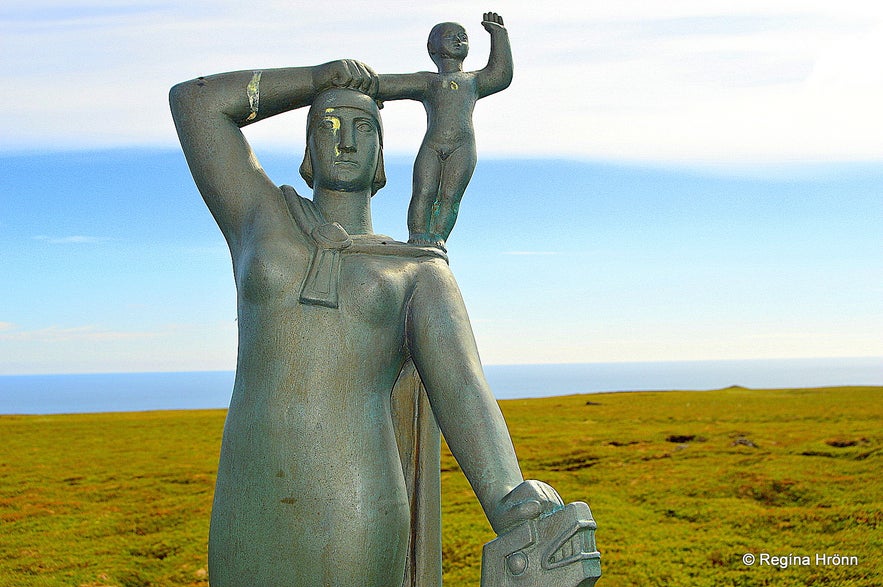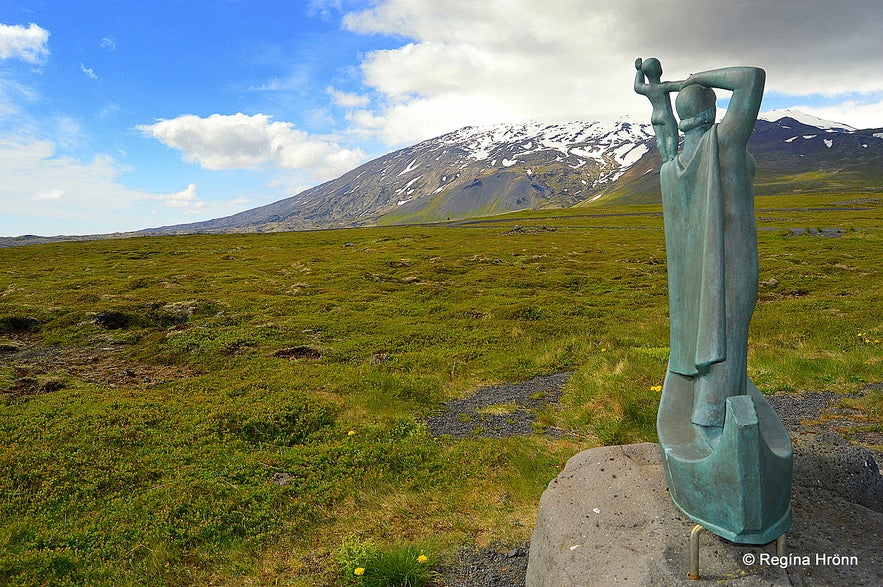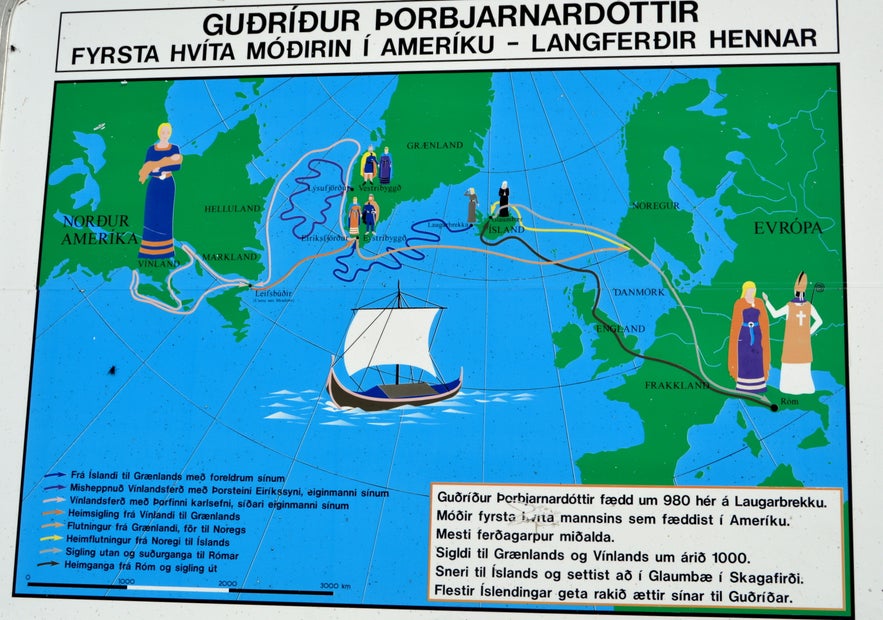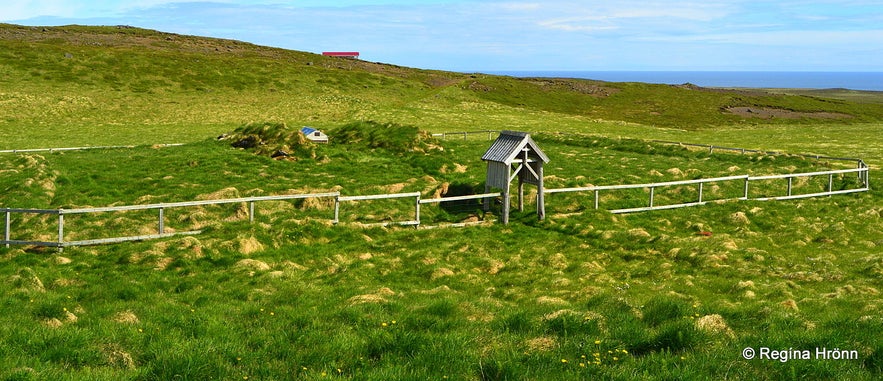
The Historic Laugarbrekka on the Snæfellsnes Peninsula and Guðríður Þorbjarnardóttir
Laugarbrekka is a well-known stop on the south side of the Snæfellsnes peninsula in West Iceland, and here the half-troll half-man and Protector of the Snæfellsnes peninsula, Bárður Snæfellsás, settled and built his farm.
Bárður lived at Laugarbrekka until he disappeared into Snæfellsjökull glacier after the incident at Rauðfeldsgjá, which I told you about in my travel-blog about Bárður.
Opening photo: a statue of Guðríður Þorbjarnardóttir
 The information sign at Laugarbrekka
The information sign at Laugarbrekka
Sigmundur Ketilsson, who had arrived in Iceland with Bárður, then lived at Laugarbrekka.
What I am going to tell you about in this travel-blog though, is not a story about a man, but an extraordinary woman, Guðríður Þorbjarnardóttir (980-1050), who was born in 980 here at Laugarbrekka at Hellnar.
Guðríður was the great-granddaughter of the settler Sigmundur Ketilsson and the daughter of Chieftain Þorbjörn Vífilsson and Hallveig Einarsdóttir at Laugarbrekka.
By the statue of Guðríður Þorbjarnardóttir and Snorri her son
In her lifetime Guðríður went on 8 sea voyages and travelled twice over the whole of Europe! She is believed to have been the most widely travelled woman of the Middle Ages.
And, she went to America long before Cristopher Columbus "discovered" it and she is most likely the first European woman to bear a child, a son by the name of Snorri, in North America.
At Laugarbrekka you will find a statue of Guðríður Þorbjarnardóttir with her son, Snorri, aboard a Viking ship.
The statue of Guðríður and Snæfellsjökull glacier
Their story of Guðríður Þorbjarnardóttir is told in two of our Sagas - Grænlendingasaga - the Saga of the Greenlanders and Eiríks saga rauða - the Saga of Erik the Red, but these two sagas are referred to as the Vínland Sagas.
In the Saga of Erik the Red Guðríður Þorbjarnardóttir is described as being "the fairest of women, and of peerless nobility in all her conduct".
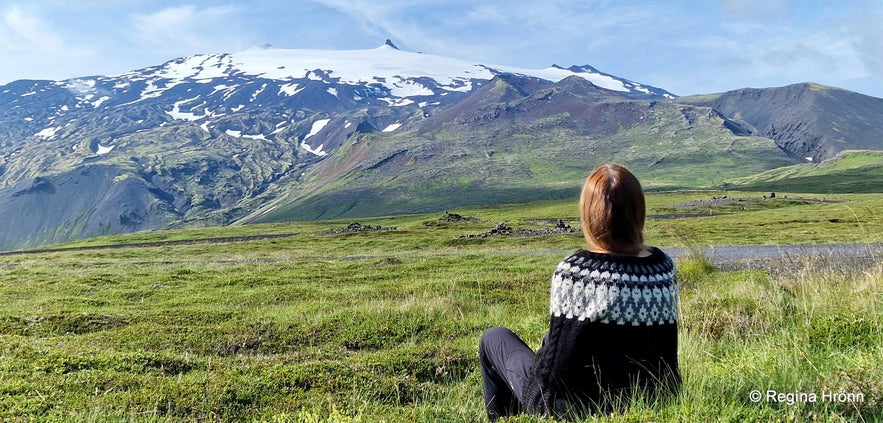 Having a picnic at Laugarbrekka with the backdrop of Snæfellsjökull glacier is ever so lovely
Having a picnic at Laugarbrekka with the backdrop of Snæfellsjökull glacier is ever so lovely
She became the foster child of Ormur and Halldís at Arnarstapi, who were great friends of her fathers and lived at Arnarstapi for a long time.
Back in those days, it was a great act of friendship to foster a child of a friend.
 Laugarbrekka
Laugarbrekka
Guðríður travelled in the year 1000 from Iceland to Greenland with her parents, where Eiríkur rauði - Erik the Red had settled.
They stayed for the first winter with a man called Þorkell at Herjólfsnes, who was the greatest of the farmers in this area.
Times were hard and famine in Greenland when Guðríður arrived with her family. In Greenland lived a seeress, Þorbjörg lítilvölva.
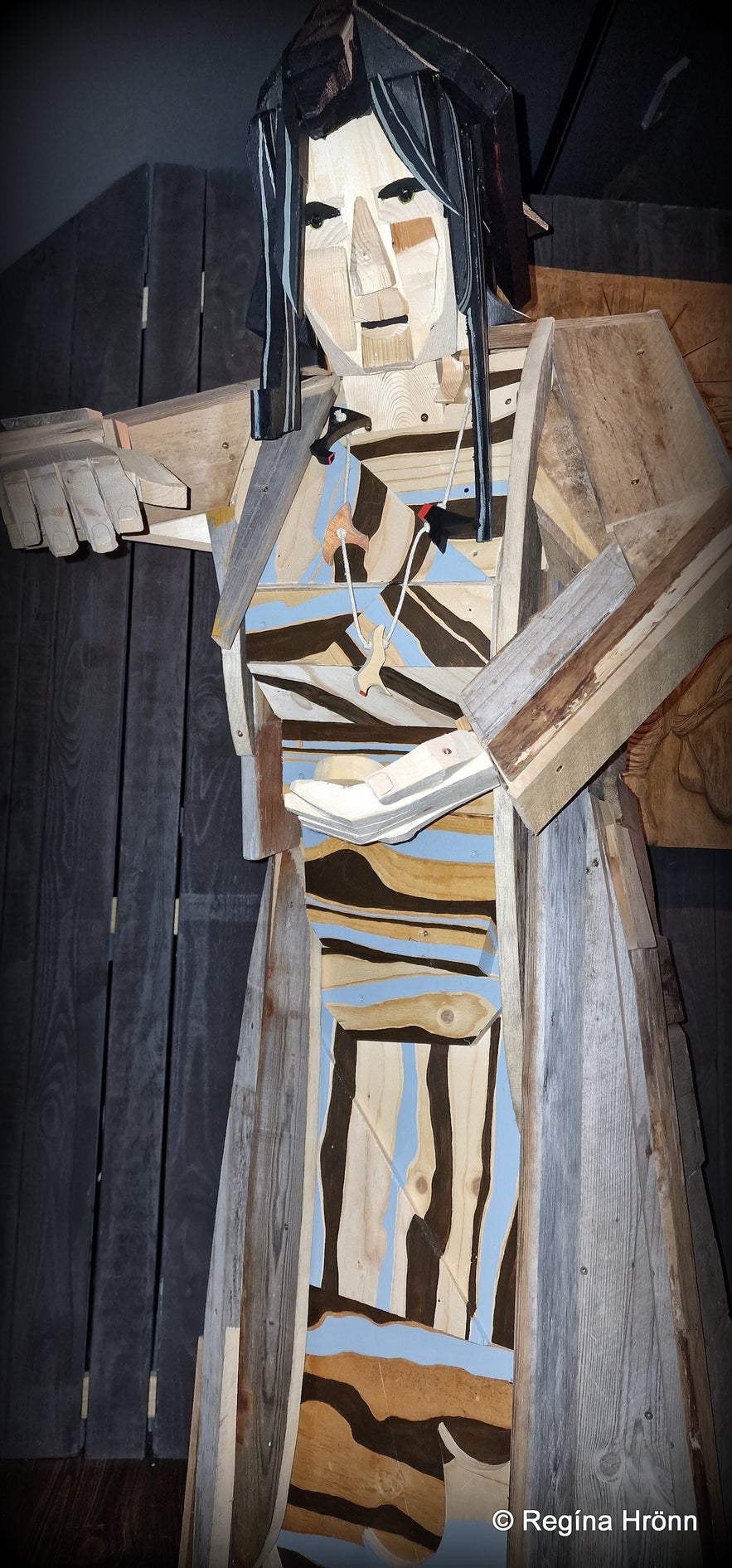 Þorbjörg lítilvölva at the Vínlandssetrið - Leif Eiríksson center in Búðardalur valley
Þorbjörg lítilvölva at the Vínlandssetrið - Leif Eiríksson center in Búðardalur valley
She was the only one left of 9 sisters, who all had this ability, to predict the future.
Þorbjörg was invited to the home of Þorkell to predict the future and to foretell when this hardship would end.
Þorbjörg was held in high esteem and a high seat was prepared for her.
She needed women who knew the lore needed for the exercise of the enchantments - the Weird-songs (Varðlokur). Þorbjörg lítilvölva as depicted at the excellent Saga Museum in Reykjavík which is a must-visit
Þorbjörg lítilvölva as depicted at the excellent Saga Museum in Reykjavík which is a must-visit
When nobody came forward Guðríður answered: "I am not skilled in deep learning, nor am I a wise woman, although Halldis, my foster mother, taught me, in Iceland, the lore which she called Weird-songs."
"That lore and the ceremony are of such a kind, that I purpose to be of no assistance therein because I am a Christian woman."
 Guðríður and Þorbjörg lítilvölva at Vínlandssetrið - Leif Eiríksson center that I recommend visiting
Guðríður and Þorbjörg lítilvölva at Vínlandssetrið - Leif Eiríksson center that I recommend visiting
This is what is written in Eiríks saga about this event (it was translated into English in 1880 by J. Sephton from the original Icelandic Eiríks saga rauða, but Grænlendingasaga is not available online in English).
Both Þorbjörg lítilvölva and Þorkell begged Guðríður to consent to doing this. Guðríður finally agreed and so beautifully sang the weird song that people had never before heard it sung so beautifully.
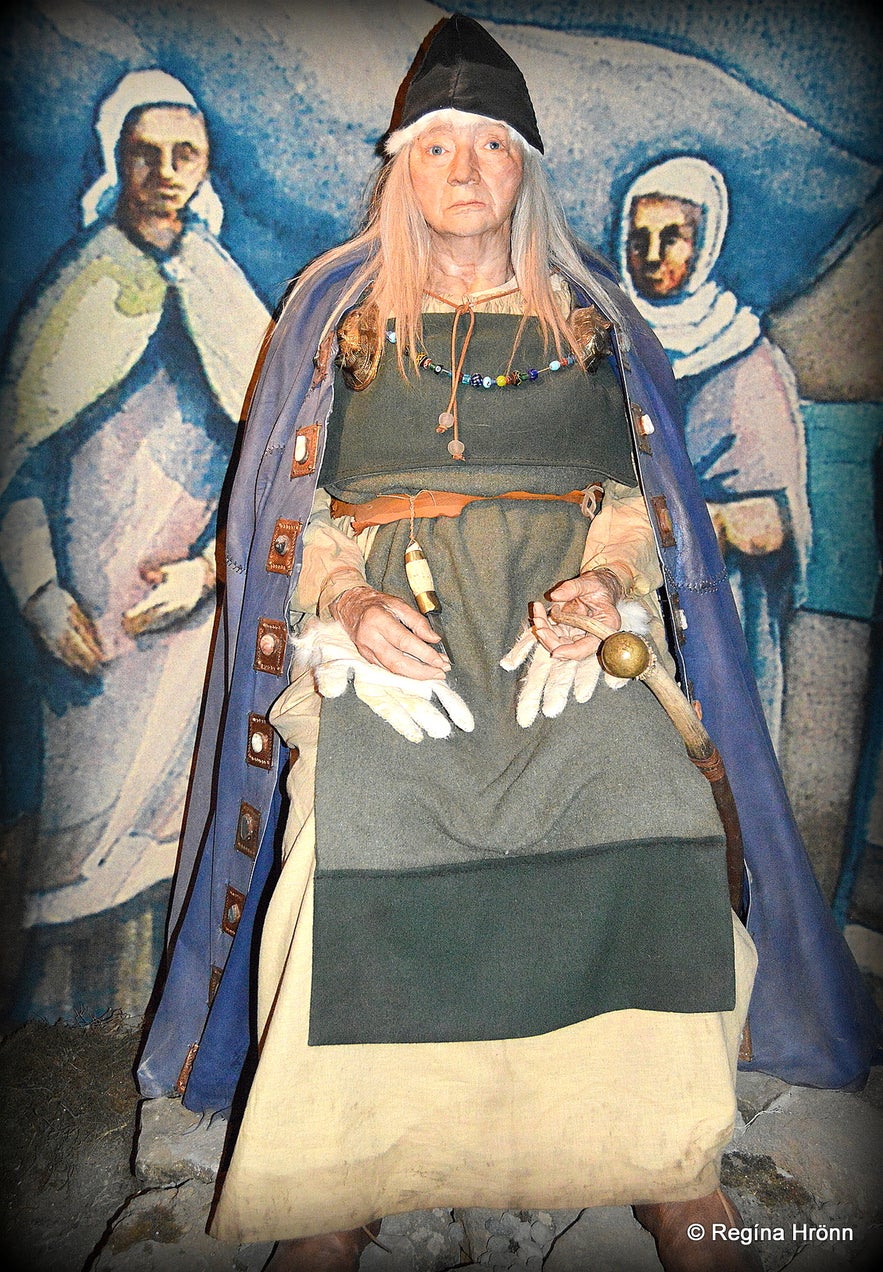 Þorbjörg lítilvölva at the Saga Museum
Þorbjörg lítilvölva at the Saga Museum
The seeress foretold that the hardship would end next spring. This is what she saw in Guðríður's destiny:
"And thee, Gudrid, will I recompense straightway, for that aid of thine which has stood us in good stead; because thy destiny is now clear to me, and foreseen.
Thou shalt make a match here in Greenland, a most honourable one, though it will not be a long-lived one for thee, because thy way lies out to Iceland; and there, shall arise from thee a line of descendants both numerous and goodly, and over the branches of thy family shall shine a bright ray. And so fare thee now well and happily, my daughter"." (As written in Eiríks saga).
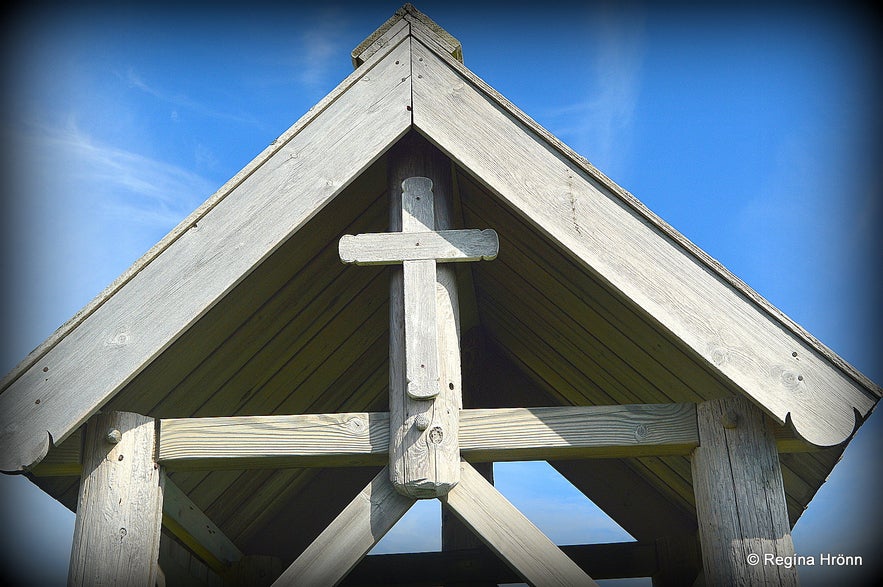 At Laugarbrekka
At Laugarbrekka
Guðríður married three times and her first husband was Þórir austmaður, who died in Greenland.
The 2 sagas tell us that on his way back to Greenland from Vínland, Leif the Lucky rescued Þórir austmaður and Guðríður Þorbjarnardóttir from a reef and took them to Greenland (15 men in all he rescued).
This is how Leifur got his nickname the lucky.
According to the Eiríks saga Leif the Lucky discovered Vínland by pure luck when he was on his way to Greenland from Norway to become a missionary in Greenland by the orders of the Norwegian King Olav Tryggvason. The Grænlendinga saga tells it differently.
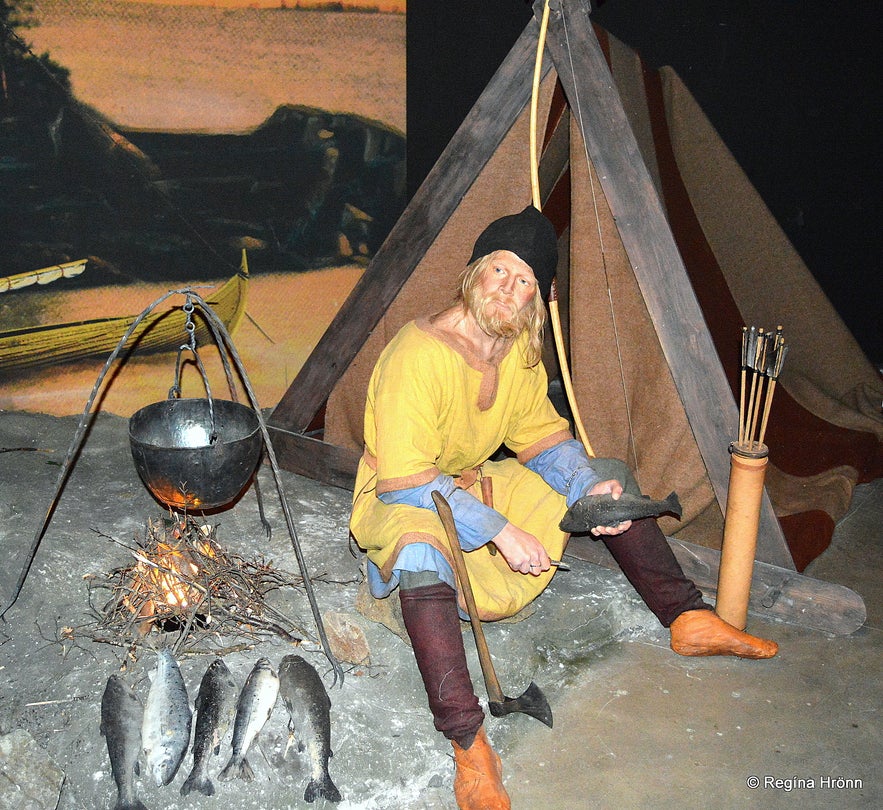 Leifur Eiríksson as depicted at the excellent Saga Museum in Reykjavík
Leifur Eiríksson as depicted at the excellent Saga Museum in Reykjavík
In that saga, Leifur wanted to find the land that Bjarni Herjólfsson had seen earlier from his ship when he was blown off course by a storm. So he bought the ship from Bjarni and set off to find this land with 35 men.
They explored this land and went back to Greenland.
You will find a wax statue of Leifur at the Saga Museum in Reykjavík, and a frightening wax statue of his pregnant half-sister, Freydís, which is a reconstruction of a terrible event that took place in the Vinland Sagas later on.
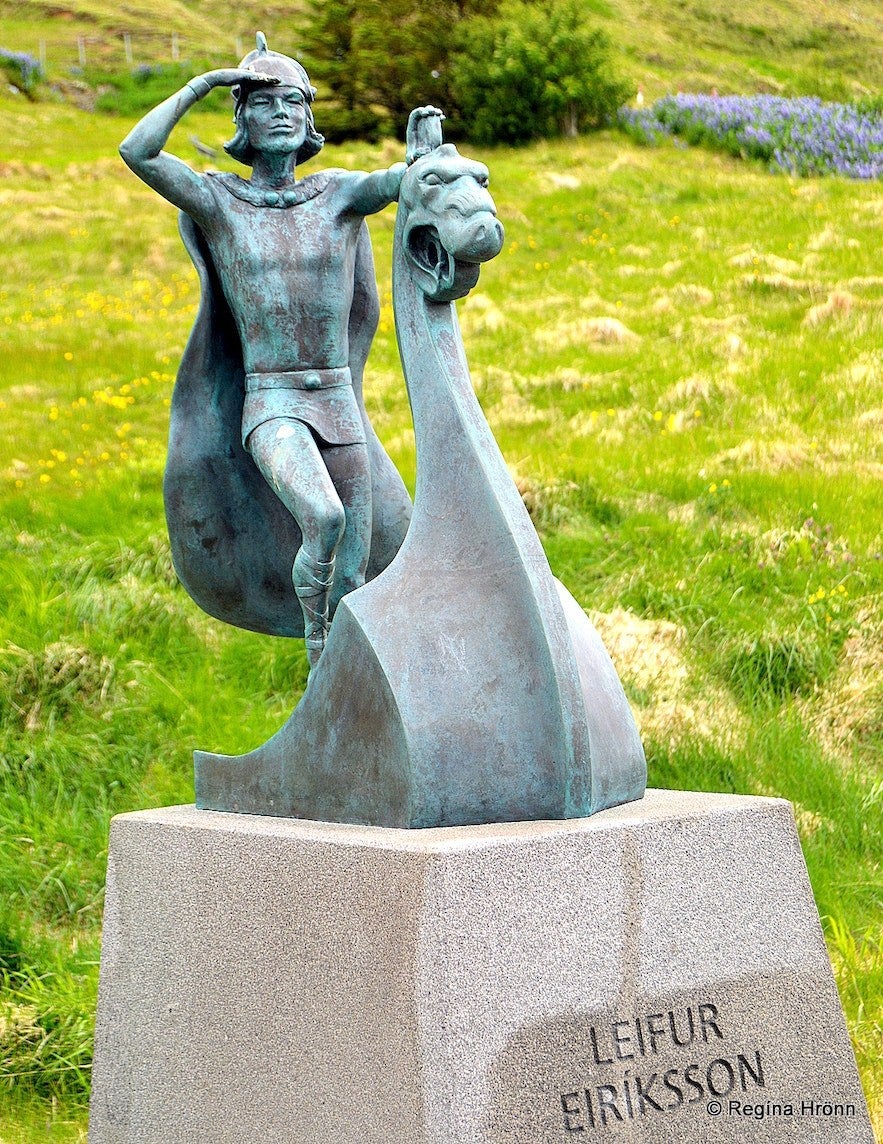 The statue of Leifur Eiríksson at Eiríksstaðir in West Iceland
The statue of Leifur Eiríksson at Eiríksstaðir in West Iceland
You can read about Leifur heppni - Leif the Lucky, and Erik the Red in my travel-blog about Eiríksstaðir - Viking Areas in Iceland - Eiríksstaðir Long House in West Iceland and Leif the Lucky.
Now, back to Guðríður. Her second husband was Þorsteinn, the son of Erik the Red and the brother of Leif the Lucky.
From Greenland Guðríður and Þorsteinn sailed to Vínland with a group of people. Þorsteinn wanted to fetch the body of his brother Þorvaldur, who had sailed to Vínland and been killed there. But they never reached Vínland.
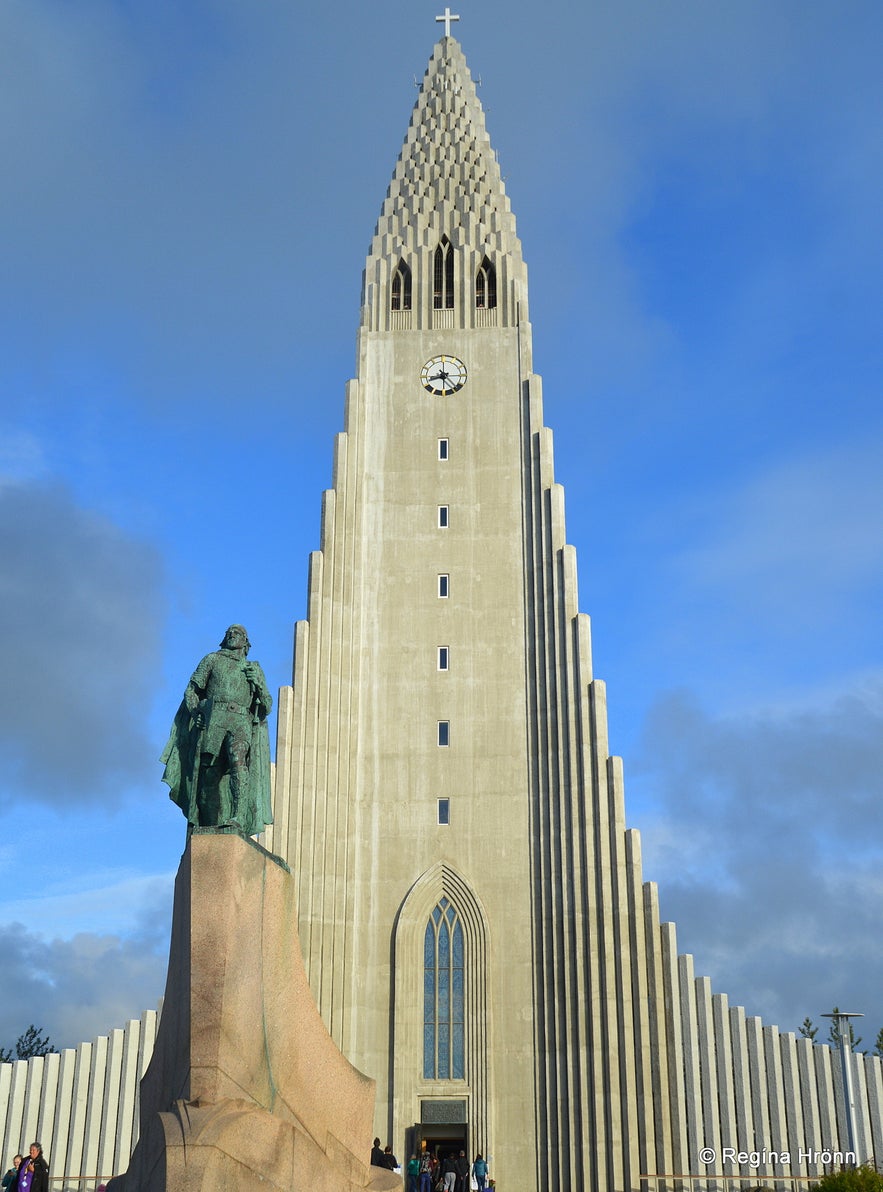 The statue of Leifur in front of Hallgrímskirkja church in Reykjavík
The statue of Leifur in front of Hallgrímskirkja church in Reykjavík
These 2 Sagas tell a different story, but Grænlendingasaga tells us that Þorsteinn fell ill and died after they had got lost searching for Vínland.
They arrived in Lýsufjörður in Greenland, where they stayed with Þorsteinn svarti. Þorsteinn's crew and Þorsteinn svarti's wife caught contagious flu and many of them died.
I am just telling you the main events here, but the story about Þorsteinn's death as told in Grænlendingasaga is fairly graphic. Þorsteinn sat up after his death and told Guðríður details about how her life was going to turn out.
A statue of Þorfinnur karlsefni in Reykjavík, Guðríður's third husband
Guðríður married her third husband, Þorfinnur karlsefni Þórðarson, in Greenland, and sailed to America with a large group of people (60 men and 5 women).
They brought with them livestock as they wanted to settle in this new land.
You will find Þorfinnur's statue in front of Hrafnista and Laugarásbíó cinema in Reykjavík. With him, she sailed to America where their son, Snorri, was born, most likely the first European child to be born in America.
They seem to have explored America all the way south to Long Island.
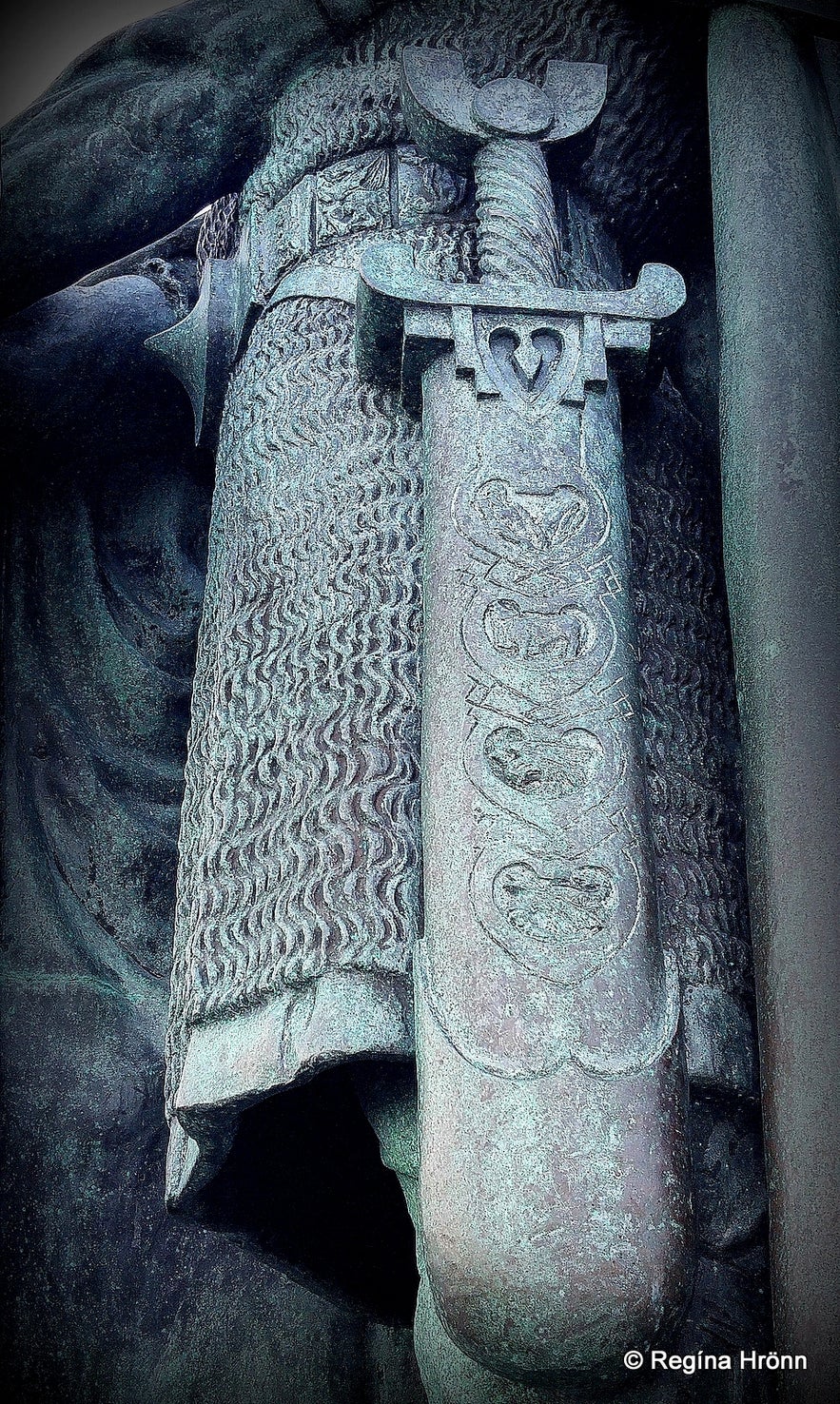
Þorfinnur karlsefni's sword
They stayed in Leifsbúðir, the houses that Leifur the Lucky had built earlier on. They didn't lack food when they arrived as a whale had beached where they settled. They hunted and fished, and had plenty of grapes to eat.
They traded with the locals, who wanted weapons and red cloth for their furrier goods, but Þorfinnur didn't want to sell them weapons. He told the women to offer milk (products) to the locals instead, which they happily accepted.
(There are now speculations about whether the Native Americans could have digested that milk. If not they might have thought that they had been poisoned by the white men, but now we are just speculating.)
 Guðríður and Snorri at Glaumbær
Guðríður and Snorri at Glaumbær
The same thing happened the following year, but now the locals were greater in number than the previous year.
The women were told to give them milk (products) and the Native Americans threw their bundles with fur over the stockade, which they had built around the farm.
By now Guðríður had given birth to her son Snorri.
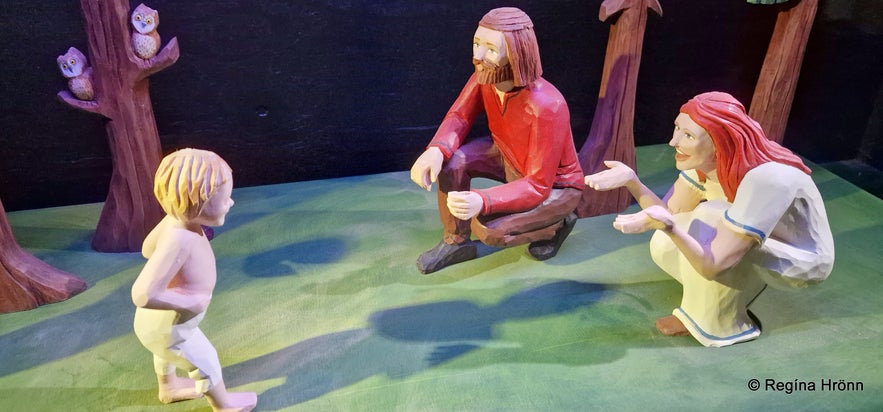 Guðríður and Þorfinnur with their son Snorri at Vínlandssetrið - Leif Eiríksson center
Guðríður and Þorfinnur with their son Snorri at Vínlandssetrið - Leif Eiríksson center
Grænlendingasaga tells us about a moment she had by his cradle when a woman with extremely big eyes approached Guðríður.
She asked Guðríður what her name was and then said that her name was also Guðríður.
Guðríður Þ. gave the woman a sign to sit by her, but then a loud crack was heard and the woman disappeared. Guðríður and Snorri at Glaumbær
Guðríður and Snorri at Glaumbær
At the same moment, one of the locals entered their home in search of weapons and was killed by Þorfinnur's men.
A battle followed between the Icelanders/Greenlanders and the locals and many men were killed.
They stayed in Vínland for the winter but understood that they were no longer safe there, so they returned to Greenland when Snorri was 3 years old.
They carried with them furrier goods, vine, and grapes.
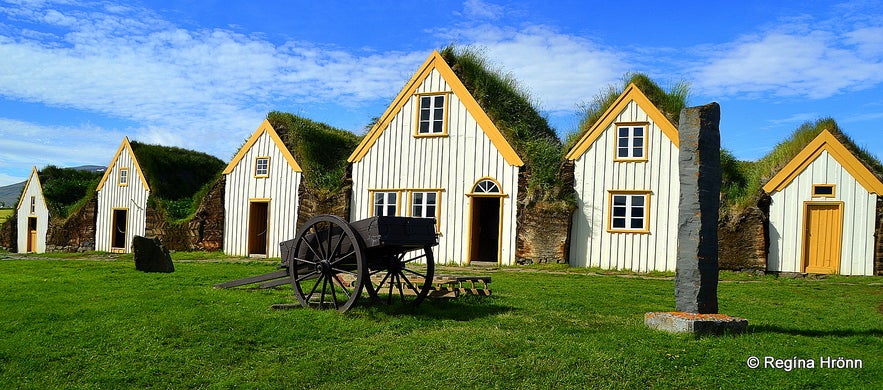 Glaumbær turf farm
Glaumbær turf farm
The two sagas tell the story very differently, so it is difficult to recapitulate, so bear with me ;)
From Greenland, they sailed to Norway and finally settled in Iceland, at the historic Glaumbær in Skagafjörður up north, where you can see a beautiful turf farm, which is now a museum.
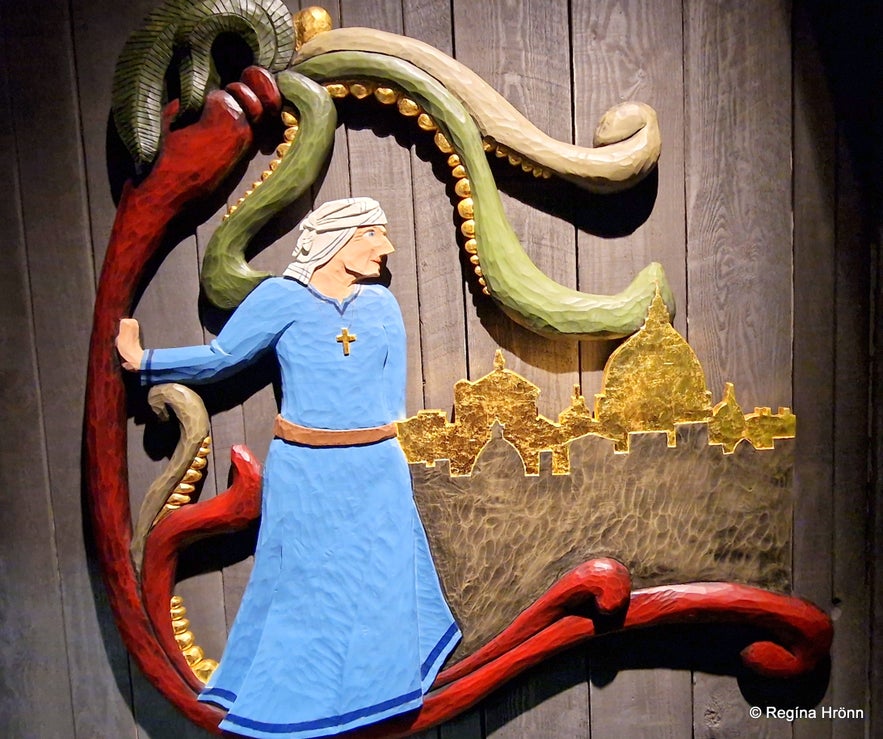 Guðríður on a pilgrimage as depicted at Vínlandssetrið - Leif Eiríksson center
Guðríður on a pilgrimage as depicted at Vínlandssetrið - Leif Eiríksson center
After the death of Þorfinnur karlsefni, her third husband, and the marriage of her son, Snorri, Guðríður travelled to Europe on a pilgrimage and walked to the Vatican in Rome.
Later she returned to Iceland and lived as a nun at Glaumbær, where her son, Snorri lived. He had built a church at Glaumbær.
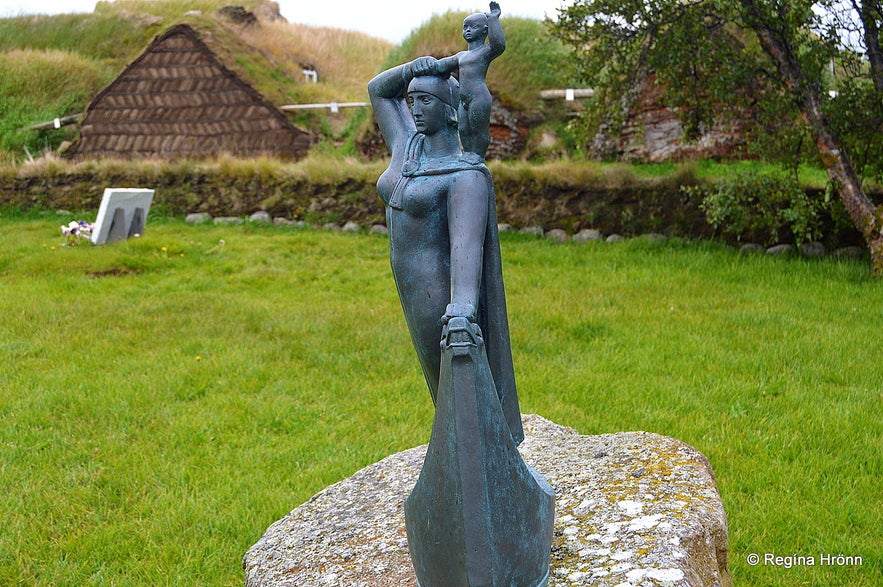
There is another replica of the original statue of Guðríður and her son at Glaumbær
Guðríður Þorbjarnardóttir was the most widely travelled woman in Iceland from the 10th century until the 20th century and it is believed that she was only around fifty by now.
What an adventurous life this extraordinary Icelandic woman lived!
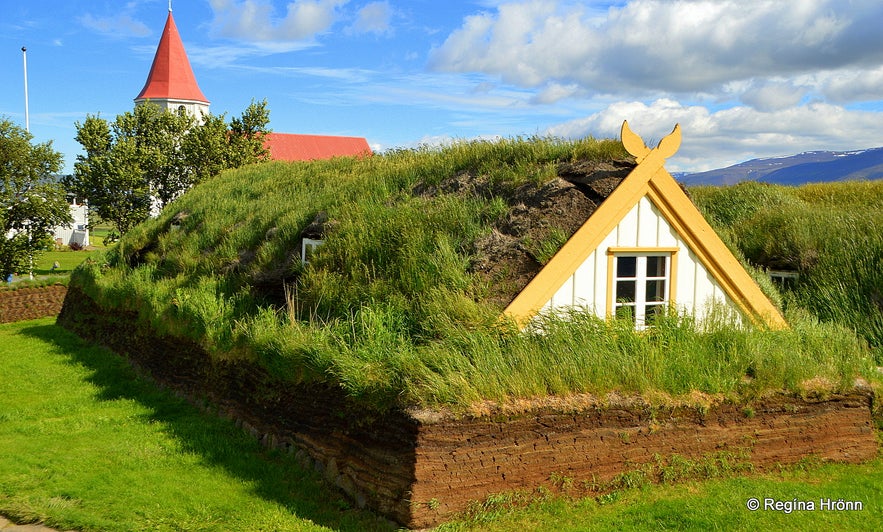 Glaumbær and Glaumbæjarkirkja church
Glaumbær and Glaumbæjarkirkja church
There is only a very short drive down from the main road to a picnic area at Laugarbrekka in Snæfellsnes by a statue of Guðríður and her son aboard a Viking ship.
You can see how widely Guðríður travelled on the map below, which you can find by the parking at Laugarbrekka.
The map at Laugarbrekka
This small statue is a casting of a bigger statue made by Ásmundur Sveinsson, one of Iceland's best-known sculptors, and was unveiled by the President of Iceland in the year 2000.
The original statue, which was made back in 1938 for the 1939 World Fair in New York, is the first statue made of a known Icelandic woman.
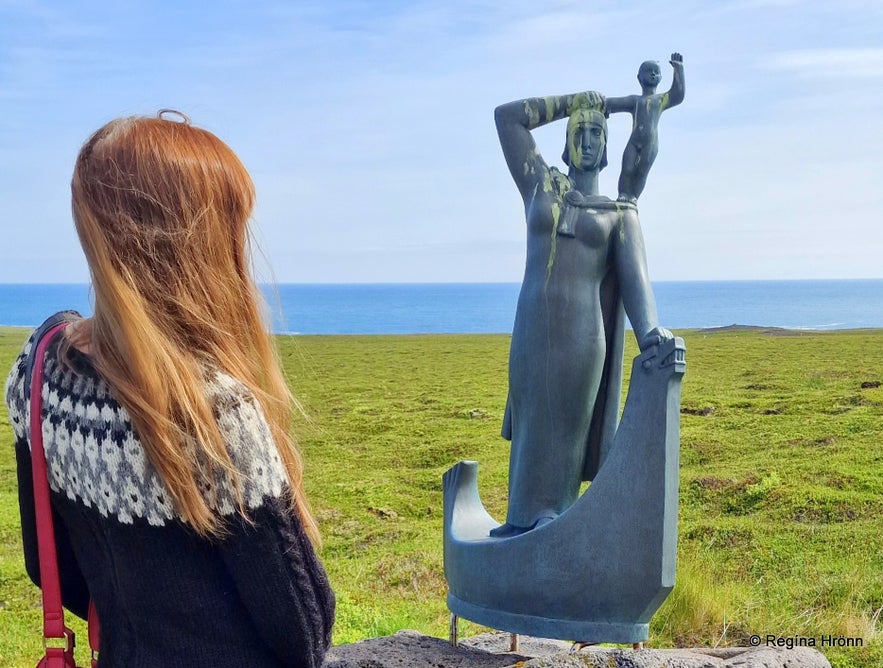 Visiting Laugarbrekka in 2024
Visiting Laugarbrekka in 2024
It is called Fyrsta hvíta móðirin í Ameríku - the first European Mother in America.
Here Guðríður is depicted as a strong, adventurous woman, which she was for sure.
In April 2022 this beautiful statue got stolen and returned a couple of days later.
At Laugarbrekka
At Laugarbrekka there was a farm and a church until 1881. Further down you will find the remains of the farm and the church.
That area is declared protected and you will see a yellow sign with Fornleifar written on it, meaning protected antiquities.
If you want to read up on the Magical Snæfellsnes Peninsula then I have written an I-V part travel-blog series about what there is to see and do on the peninsula.
The Magical Snæfellsnes peninsula - part I
The Magical Snæfellsnes peninsula - part II
The Magical Snæfellsnes peninsula - part III
The Magical Snæfellsnes peninsula - part IV
The Magical Snæfellsnes peninsula - part V
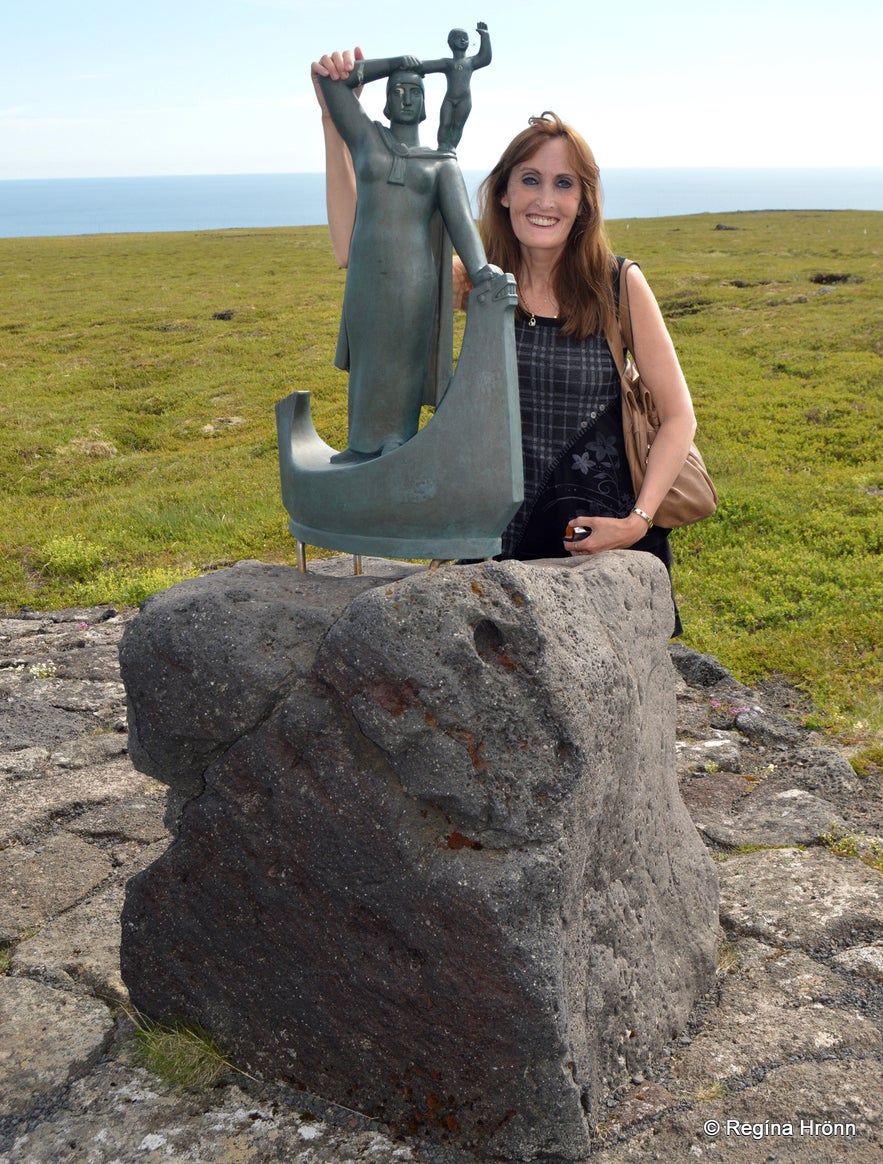 Guðríður is my ancestress 26 generations back
Guðríður is my ancestress 26 generations back
I recommend a visit to the Saga museum in Reykjavík and Vínlandssetrið - Leif Eiríksson center in Búðardalur if you want to know more about the settlers of Iceland and the people who went to Greenland.
The historic Laugarbrekka is located on the south side of the Snæfellsnes peninsula by the road Útnesvegur number 574. Here you can see the exact location of Laugarbrekka on Google maps.
To visit this area you can rent a car in Reykjavík and drive up to Laugarbrekka in a couple of hours.
Have a lovely time on the Snæfellsnes peninsula :)
Sources:
Grænlendingasaga (Icelandic)
其他有意思的博客
冰岛最浪漫的角落
对于很多人,遥远的冰岛有着世界尽头的神秘,有着区别于巴黎、马尔代夫、自成一体的浪漫。没有埃菲尔铁塔和蒂凡尼,没有热带沙滩,而是在冰川、火山、苔藓地的背景下蜜月旅拍、婚拍,甚至举办一场冰岛婚礼。来冰岛旅行,多是要跨千山万水、飞跃大洋大陆,很有一点“万水千山陪你走过”的史诗感。难怪很多人说,光是冰岛二字,就足够浪漫了。 冰岛虽然不大,但是地貌极其丰富,不同的自然景观自然有不同的气质。这一篇,就挑阅读更多从极光观测到摄影-到底该不该来冰岛看极光
很多朋友都想来冰岛看极光,但是冰岛到底适不适合看极光呢?几月、什么季节能看到极光?是不是一定要参加北极光旅行团?如何能拍摄出美丽的极光照片呢?在冰岛住了好几年了,从刚开始逢极光必出门,到如今家里阳台就能看极光,我对在冰岛看极光的了解和经验,也算得上大半个专家了,且听我娓娓道来吧。 到底该不该来冰岛看极光呢?最坦诚的答案是,不要只为了看极光而看极光。 极光原理 太阳活动→太阅读更多
迷失冰岛的米湖游览推荐|不只有温泉的地热宝藏区
我在冬夏秋均到访过米湖,看过米湖的不同面。一直以来,米湖到底值不值得去是很多游客争论的问题。有些人觉得这里是来冰岛旅行的必去目的地,有些人则说米湖“太丑了”,连照片都不想多拍几张。那米湖到底值不值得来呢?到底怎么玩呢? 米湖的风景 北部的米湖,因地理位置相距首都雷克雅未克略远,很多来冰岛的短途游客选择放弃,其实米湖应该是和黄金圈、南岸沿线至冰湖齐名的冰岛景色,这里冷热相融,可谓最冰岛,尤其阅读更多

将冰岛最大的旅行平台下载到您的手机中,一站式管理您的整个行程
使用手机摄像头扫描此二维码,然后点击显示的链接,将冰岛最大的旅行平台添加到您的手机中。输入您的电话号码或电子邮件地址,以接收包含下载链接的短信或电子邮件。

